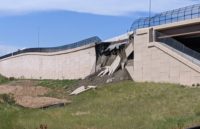A week after heavy rains delivered what many in the area termed a 1,000-year-flood, state and local officials were still scrambling to complete rescue efforts in northern Colorado's devastated communities and begin initial cleanup and repairs that will take months, if not years, to complete.
At least eight people died, tens of thousands were evacuated, and nearly 18,000 homes and 1,000 businesses were damaged or destroyed in the raging floodwaters that tore through the foothills and onto the northeastern plains. The rains, measured in Boulder by the National Weather Service at 21 in. over a few days, resulted from the collision of a northern cold front with monsoonal moisture, stalled over the region, from the Gulf of Mexico. The Denver metro area was spared the brunt of the floods and suffered only minor damage.
But in the canyons and foothills along the Front Range between Boulder and Fort Collins, streams and rivers swollen by the rains swept away roads, bridges and structures, leaving behind junkyards of debris and areas accessible only by helicopter or on foot. Towns and neighborhoods became islands. In some places, waterways left their banks and carved channels hundreds of feet away, creating new rivers where roads had been. Downstream, on the eastern plains, the floodwaters swamped thousands of acres of farmland, killing crops and livestock and damaging oil-storage facilities. More than 27,000 gallons of oil was spilled along the South Platte River valley. While the high water shut down 1,900 oil wells, about a third have since resumed operations, according to the Colorado Oil and Gas Conservation Commission.
Colorado Gov. John Hickenlooper (D) called it "utter devastation" and declared 17 counties disaster areas, promising more state aid. State officials place early estimates of property damage alone at $1.36 billion. The Federal Emergency Management Agency already has provided $12.3 million in emergency aid, with more expected as inspectors gain access to the worst-hit areas. More than 14,000 people have applied for assistance.
The Colorado Dept. of Transportation says it lost 50 bridges and more than 200 miles of highways. Two weeks after the storm, sections of 15 major roads remain closed. CDOT released $100 million in contingency funds and received $35 million from the U.S. Dept. of Transportation in "quick relief" monies for repairs, but Hickenlooper said long-term rebuilding could cost "several hundred-million dollars."
The governor, who toured damage in the canyons by helicopter with Vice President Joe Biden on Sept. 23, is seeking $500 million in federal emergency funds. For that to happen, Congress would be required to lift the $100-million emergency cap, as it did for areas hit by Superstorm Sandy. After the tour, Biden said the initial emergency funds from the federal government "aren't going to be enough. We're going to keep working with the governor until we make you whole."
The governor set a Dec. 1 target date for completion of temporary road and bridge repairs. Meanwhile, CDOT has formed an infrastructure recovery force to spearhead emergency repairs.
The phased plan includes help from the National Guard and private contractors who are using fill material and gravel paving combined with military-style modular bridges to provide faster access to towns cut off by the floods. A long-term reconstruction phase will redesign and rebuild highways through high-risk areas to make them more flood-resistant.
CDOT issued contracts on Sept. 23 for four contracting teams to begin road repairs and reconstruction. The agency selected Kiewit Infrastructure Co., Littleton, Colo., to make temporary repairs on U.S. 34 through Big Thompson Canyon; Skanska USA Civil West, Cortez, Colo., and Ralph L. Wadsworth Construction, Draper, Utah, to repair state Highway 7; and Lawrence Construction Co. and URS Corp., both of Denver, to work on highways east of I-25. Lawrence also will repair state Highway 72 through Coal Creek Canyon, near Denver.
"There is no set cost for these contracts and no liquidated damages," says CDOT spokeswoman Amy Ford. "We are aiming for a Dec. 1 completion. But that's a goal, not a firm deadline. We will pay them whatever it takes to do the work, and they are starting it immediately." The repair contracts were issued on a qualifications basis, not as low-bid jobs, she says.






Post a comment to this article
Report Abusive Comment